For over a year now, I’ve been enjoying playing (mostly as the Dungeon Master or DM) with the new D&D 5e rules. My history with the game, however, began with the Basic Set in 1979-1980; in addition to the single rulebook and low-quality dice tucked inside the box was a module, B2 Keep on the Borderlands. This module (and many more like it) offered the details the DM would need to run the adventure, including the removable cover that contained the maps for the DM to reference and use to provide descriptions to the players such as the dimensions of a room or the distance to cross a bridge. Large laminated mats weren’t a common site at most gaming tables, but letter-sized sheets of graph paper (with baby-blue lines) were; players were often tasked with creating their own map of their travels, especially for underground dungeons, and graph paper was sometimes an option. So, while the DM had a nice bird’s-eye-view of the dungeon or caves or other structure or terrain, (as well as text descriptions in the module booklet) players typically had to rely on their imagination when hearing a room or cave described, for example.
Being a DM in those early days involved mostly what is referred to as theater-of-the mind (TOTM)… basically asking the players to visualize scenes, creatures, and combat and providing answers to their questions. I can recall a time in the early ’80s when I began seeing more and more miniatures; most often they were used to help the players and DM visualize marching orders or positioning during combat, but a few crafty DMs could be spotted providing hand-drawn rooms or maps for the players to place their miniatures. But for the very early days of D&D play (at least in my corner of the world), the traditional D&D games consisted of TOTM and players drawing their own maps as they explored the world.
Note: One of my earliest memories of seeing miniatures used in real combat gaming was at a sandbox table at (if memory serves) a local gaming convention in Pensacola, FL, where a group of wargamers had set up a large ping-pong sized table with buildings and a river and other obstacles. I believe it was a Napoleon-era style battle based on the painted uniform jackets and hats and the players had obviously gone to great lengths to create this beautiful miniature battlefield. I believe my seeing that tiny battlefield and all its details has greatly influenced my role as DM and why I’m not a traditional TOTM gamer.
Today, many DMs still rely on TOTM; it’s a tried-and-true method of storytelling and many players prefer this kind of play with its typically speedier gameplay and minimal expenditure. But even in those early days of D&D, it didn’t take long for gaming aids to appear for both players and DMs.
In the early and mid ’80s, my most frequent source for ideas and inspiration came from Dragon magazine (or The Dragon for very early issues that I never owned). Tucked in those pages were adventures, new classes and spells and monsters, and plenty of articles for DMs looking for something new to toss at their players. And mixed in with all this content were the advertisements, too. Most of them were often out of my price range — I was in middle school when I began playing D&D, and I was too young to have a job other than mowing lawns — or not relevant to my gaming needs. But there were a number of advertisements that always managed to catch my eye – these were the ones related to 2D mapping or creating floor plans for gameplay. I was always on the lookout for ways to bring the game to life with my players and these always caught my eye.
So, what kinds of 2D terrain aids were becoming available for players and DMs? Let’s take a look.
Note: The advertisements below were found in The Dragon/Dragon magazine. There may very well have been earlier instances of these adverts in other sources such as self-published zines or media local to the particular businesses.
Legacy Products
The first notable instance of a game aid that I could find was from the Imperium Publishing Company – It was called Netherworld and sold for $6.95 (1977 USD). Described as the “First Three-Dimensional, Geomorphic Underworld Construction Kit For Assembly And Take-Down DURING Adventuring,” the image showed a rectangular shaped dungeon (actually requiring two kits). While technically a 3D terrain kit, I’m including this one here simply for being what I believe to be the first terrain game aid for sale in The Dragon magazine as well as the fact that the walls looks sufficiently low to almost qualify as 2.5D (which will be discussed a bit later in the modern product section below).

A better quality image of the same two-kit dungeon was later spotted in The Dragon #14, May 1978.

I have looked high and low for a boxed set of Netherworld, but have had little luck. From the images, it looks like this was a fairly sturdy set of cardstock floors and walls. The advert does state that the dungeon in the image consists of two kits, and I’m counting only 7 or 8 rooms and 2-3 hallways, so this appears to have been one of those kits where you’d need four or five of them to create a rather large dungeon. It’s also difficult to tell from the image how you would have built lengthy hallways that led to single rooms; the sample dungeon seems to indicate that connected, rectangular dungeons were the limits of the kit.
Note: If you have any first-hand experience with any of the products mentioned here, please do share.
For the last few seasons of Adventurer’s League, I’ve turned to my 24″ x 36″ laminated grid map from Role 4 Initiative for many adventures. I typically make black-and-white photocopies (oversized) using a special copier at the print shop and then use these to hand-draw any special maps I may need. This kind of blank grid map, however, has been around for some time in many sizes and brand names. The earliest advertisement I could find was for a product simply called Campaign Map from Indicia Associates. Not a bad deal, either — $1.10 (1979 USD) for a 22″ x 34″ or $1.95 for a 34″ x 44″ sheet.

My best guess is these were printed on paper and not laminated. And since shipping costs were extra, they were probably only affordable if you bought them in large quantities. I personally never saw any sheets this large used in the early ’80s; instead, I did see some DMs taping together numerous 8.5×11 sheets of graph paper together and drawing rooms and tunnels as oversized terrain on them. Still, I could easily see how beneficial these flat sheets could have been to DMs (and I’d love to have one in my collection if I could ever find one).
Someone at Dragon magazine must have been keeping their eye on these new products, because in issue #45 (January 1981), the magazine offered up The Dragon Dungeon Design Kit. With three pages of text instruction and eight pages of cardstock printings containing chests, tables, walls, and more, DMs were given a nice little (and inexpensive) kit to layout rooms for players to examine and place miniatures if they had them:
[Players] can enter a detailed, furnished room, instead of being given a “mere” verbal description of what they have encountered. The ability to visualize your character’s surroundings is something that greatly enhances a player’s enjoyment of a role-playing game, and we feel that players can more easily get into the spirit of adventuring if the images they’re visualizing are taken out of the mind’s eye and spread out right in front of them. – Dragon #45, January 1981, page 38
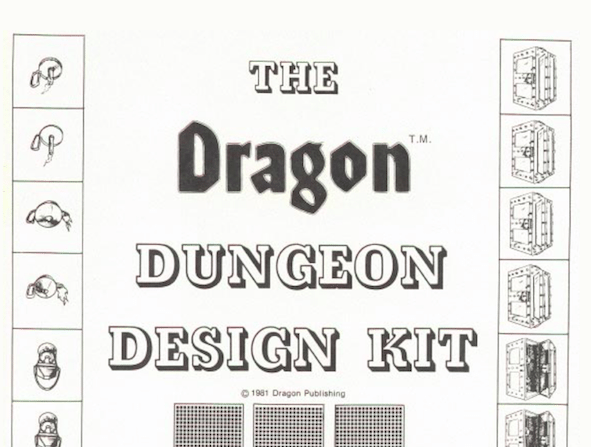
DMs and players could purchase extra sheets (up to two per person) for $2/sheet from Dragon magazine. Game clubs were encouraged to combine the kits from multiple copies of the magazine to create a larger collection of components (over 100 double-sided chits were provided per issue).
[M]any of the components are printed on both sides. In general, items constructed of metal and/or stone are represented on one side, and things made of wood and other materials are shown on the other side.There are enough linear feet of wall sections to build a 100-foot-square room or the equivalent thereof, not counting the space taken up by doors or passageways which lead through walls. The wall sections come pre-measured in scale sizes ranging from five feet to 50 feet long (one inch to 10 inches actual measurement)… – Dragon #45, January 1981, page 38
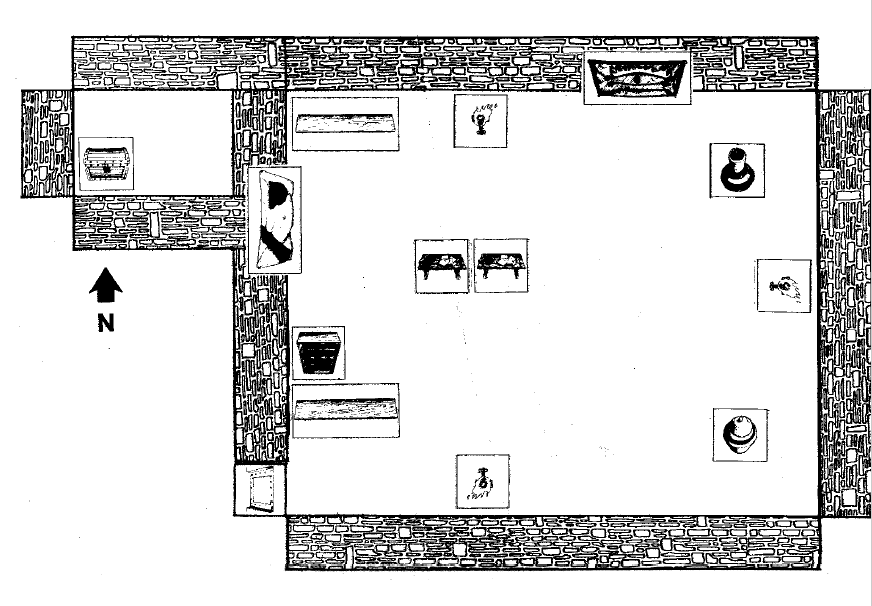
Two months later, a black-and-white advert for a similar but more polished kit would appear for sale. Dungeon Tiles by Task Force Games offered up over seventy 2″ x 2″ colored terrain tiles along with a few oversized rooms and a large collection of punch-out chits that represented things such as fire, chair, and blood plus small slips of paper to represent ladders, bridges, and tables.

The first thing you might notice when you begin to put the tiles together to form hallways and rooms is that they’re not perfectly aligned when it comes to walls and corners. Some tiles have black borders on all sides, requiring a door chit to be placed to indicate passage from one area to another. There are a lot of duplicate tiles displaying the same broken sword or bone fragment, and the ground is a solid brown with large stones representing the floor. There is no variation in floor material, although there are a few spiral staircase tiles. Surprisingly, the card stock material lays flat easily enough although a good sneeze or cough would likely send a piece or two flying.
While this is clearly a perfect example of a product in its infancy, I think credit must be given for providing something that brings players and DMs a step closer to more realistic scenes and allows for miniatures, creatures, and other special items to be placed to give a better idea of relative positions.

Also tucked into the box was a 4-page set of ‘Rules for Use’ with the following instructions:
DUNGEON TILES are not intended to be used for dioramas or displays (although they could be used to good effect for that purpose). DUNGEON TILES are intended for use as an integral part of the game system during all phases of dungeon exploration… [using] DUNGEON TILES gives the players an immediate grasp of the tactical situation and eliminates the practice of using die rolls to determine who is closest to the monster approaching…

As someone who loves learning more and more about the history of gaming, I also found this little bit of info at the end of the instructions booklet:
The original concept for DUNGEON TILES was first demonstrated to the Amarillo Wargame Club in 1976 by Paul Michael Smith, who had learned the system from his playing group in Dallas-Fort Worth… DUNGEON TILES artwork by A.J. Belflower, Illustrations and counter-sheet artwork by R. Vance Buck, Stephen G. Wilcox, Stephen V. Cole.
As one of the very first 2D terrain gaming aids, Dungeon Tiles likely got a lot of use from DMs and players who discovered the fun of having physical tiles for gameplay.
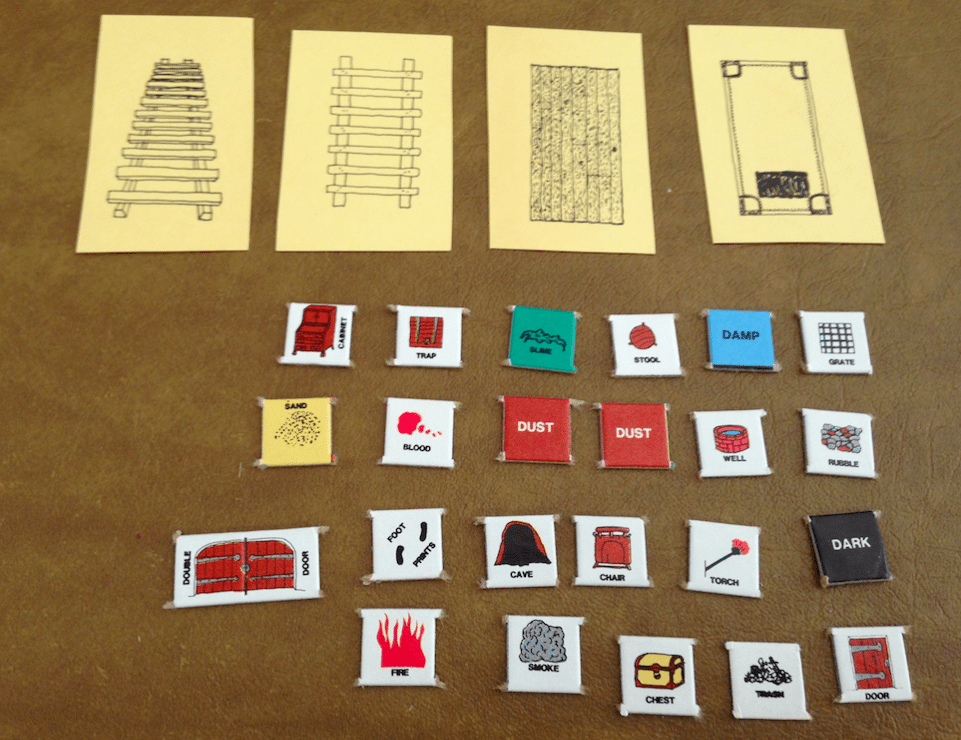
In the May 1981 issue (#49) of Dragon, another game aid appeared that wasn’t a proper dungeon tile, but it did offer something similar. Called Dungeon Drawings, it offered up 30 unique room sketches for Set No. 1 (and I can find no future advertisements for a Set No. 2). Printed as 5.5″ x 8.5″, it’s not indicated whether they drawings were printed on standard paper or card stock.

As described in the advertisement, there would likely be a number of problems with a product like this, namely that with pre-drawn rooms a DM would be pretty much limited (or required) to address what is seen in the drawings. The four sample drawings also all seem to show the same perspective and indicate a fairly limited four-wall room mentality. Still, points for creativity and trying to offer up DMs something to help in their games.
The only imagery I can find for Dungeon Drawings are the four examples in the advertisement itself; I’ve looked everywhere for this product, but no luck. There’s no company name and it remains a residential address. If anyone has any information or imagery to share about this product, please let me know – I’d love to see all or some of the missing 26 images.
Next we come to another boxed set of tiles from Board-Craft Simulations, Inc. It was called Fantasy Paths, and the kit offered up a set of heavy-duty cardboard tiles with black-and-white imagery (and a minor amount of color) printed on both sides. With 28 tiles, the DM had 56 unique areas to place down on the table. As with the previously mentioned Dungeon Drawings, however, many of these tiles locked in the DM to include in the room or hallway’s description anything unusual appearing on a tile. While the DM might like to use the small square room with the large dining table, the five sandbags in the corner would have to be explained… or the players simply told to “ignore that.”

The tiles also lacked a standard-sized grid pattern. Large tiles had 1″ grids on the ground, but the smaller tiles had random sketches of stones or other objects that didn’t adhere to a 1″ grid system. The thickness of the tiles would ensure the tiles stayed where placed. All the tiles were numbered (a blue numeral on one edge), and the artwork was bird’s-eye view/top-down with a bit of isometric fudging of walls. What most impresses me about the tiles, however, is how well they match up when placing them side by side. Players needed to accept the fact that a door on one tile would override a solid wall on another tile, but other than that you could really see how a story could be created using these 56 basic scenes.

In addition to the tiles, a number of small 1″ chits were included with simple line drawings of heroes and creatures and some numbered chits (in various colors to be used in place of dice if necessary, 2d10, 1d4, 1d6, and 1d8 options). My personal favorite is what appears to be a bear with a pumpkin head. Not kidding — see image below.
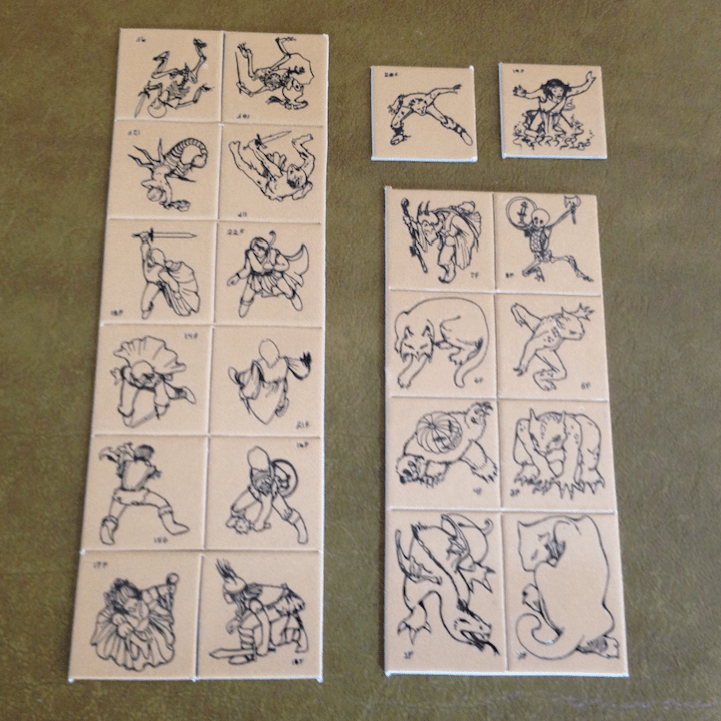
A four-page BASIC ADVENTURE booklet was also included that referenced 24 of the tiles and provided an adventure titled ‘The Necromancers Lair’ [sic]. From the document:
Story: A new sorcerer has moved his new abode into the area around Traxler. The local townspeople are in need of a party of adventurers to explore the Necromancers [sic] Lair and, if possible, drive him away. The only thing known of the Necromancer is that he possibly has a sense of humor…
I mean, who doesn’t prefer a necromancer with a sense of humor? But it gets better. If the players manage to survive the traps and various creatures and reach the actual necromancer’s room, there’s apparently no way to win! Here’s the notes for the DM:
The Necromancer will not respond to the players at all but continue to laugh. If the adventurers try to leave the room, or do not attack, the Necromancer will point at a finger at the closest one to the door and the adventurer will disappear. This will continue until all the players either attack or are all gone. If the players attack, they will; A) Become enveloped in a dark cloud of smoke, blocking out all light. B) As the smoke begins to clear, the adventurers will find themselves back at the doorway leading into Room No. 2 (including all those players killed) in the same order and condition as when they entered at the start of the game. The lead adventurer will have an arrow stuck in his chest… with a note on the shaft that reads “GOTCHA”. Note: Should the players try to leave the dungeon early, or are all made to disappear by the Necromancer, then skip to Part (A)…

No info on the Necromancer’s stats, no way to kill him, and no way to exit the dungeon. This was 1981, so keep in mind that adventure creation has definitely come a long way since then.
Finally, the box also included a 16-page document titled Basic Role-Playing: An Introductory Guide by Greg Stafford and Lynn Willis (and published by Chaosium, Inc). It’s an interesting read – it discusses what a fantasy role-playing (FRP) game is, and how it operates. The rules are very limited (no magic classes), and a character can be summed up on a 2″ x 6″ mini character sheet. The booklet would still have been an outstanding document for someone unfamiliar with RPGs in 1981; plenty of discussion on the mechanics of a game, the use of dice, combat, etc. Reference tables were simple; everything fit on page 16 including a sample character’s stats. This booklet is absolutely one of my favorite documents, giving a glimpse into those early days of RPG development.

Note: There were two other boxes in this series – Castle Paths and Village Paths. I haven’t had first-hand experience with these, but they were supposed to contain similar tiles but with castle and village locales.
Rounding out this “legacy” section of mapping/tile game aids are a few little advertisements that appeared in Dragon magazine but which I’ve been unable to find any additional information.
This advert for Battlemats & Megamats appeared in May 1983. I don’t think it’s the same company that offered the Campaign Map, but I could be wrong – sizes were slightly different and this one was from Berkeley Game Company. You could write on them, erase, and roll them up and take them with you. The only difference between Battlemats and Megamats were their sizes – 23-1/2″ x 26″ versus 32″ x 48″.
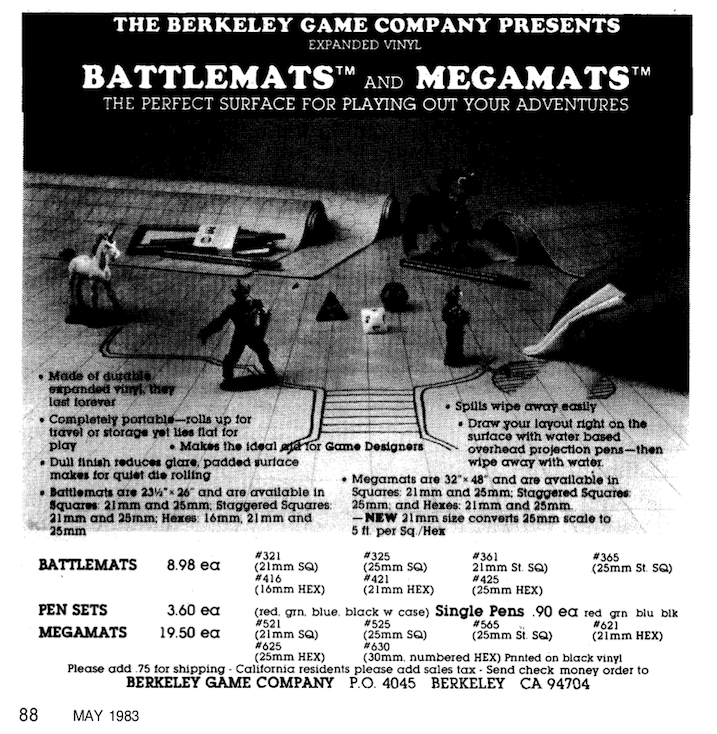
Another product called Endless Plans showed up in the September 1983 issue of Dragon. This one had a drawing instead of a photo of the actual product, and was for the “discriminating FRP gamer.” There were four sets (Labyrinthine or Spacious Dungeons, and Tortuous or Cavernous Caves), each with twenty sheets to be cut up into tiles. Again, I’ve searched and searched but found nothing on this product. I’d love to see what it offered and the quality of the tiles, but this one may have disappeared forever.

Finally, how could a DM say no to Walls Walls Walls? Three options were available for $2.75 each, sight unseen. Even if I’d had the money, I doubt I would have sent off for these without some more details, but maybe someone out there reading this remembers the products? It sounded great – 20′ of materials that required some assembly, but if it truly delivered “sturdy, realistic” castle, cave, and dungeon walls, there were probably some lucky players having fun with these items.

I have no doubt that there were other products available, many probably not advertised in Dragon and likely sold as hand-made items at conventions and in local gaming stores. These were what gamers had to work with, however, and at the time I’m certain most gamers were quite happy to have anything that added to their enjoyment.
But 2D terrain aids didn’t die off… they’re alive and well today. I can only offer up some examples from products that I’ve found and used, so feel free to add additional products in the comments section below if you’ve got some good recommendations.
Modern Products
There are so many options available to DMs today when it comes to 2D terrain. There are numerous products offering up tiles and modern versions of the Battlemat variety from folded to rolled to print-it-yourself. If you’re on the lookout for some modern 2D terrain products, I have a few below (most of which I can recommend based on actual usage).
Fat Dragon Games
I’ll start with a tried-and-true product – Fat Dragon Games and its 8″ x 8″ Copper Dragon series of 2D terrain tiles that are printable from a PDF. You don’t order these as a kit – you buy a PDF file, print them out, and mount them to foam core or cardboard if desired. I can’t speak for all the Fat Dragon 2D files, but the two I’ve ordered – Caverns 1 and Caverns 2 – offer a ton of variations of twisting tunnels, bottomless pits, and cavernous rooms. I print them out in black-and-white and use spray adhesive to adhere them to foam core board.
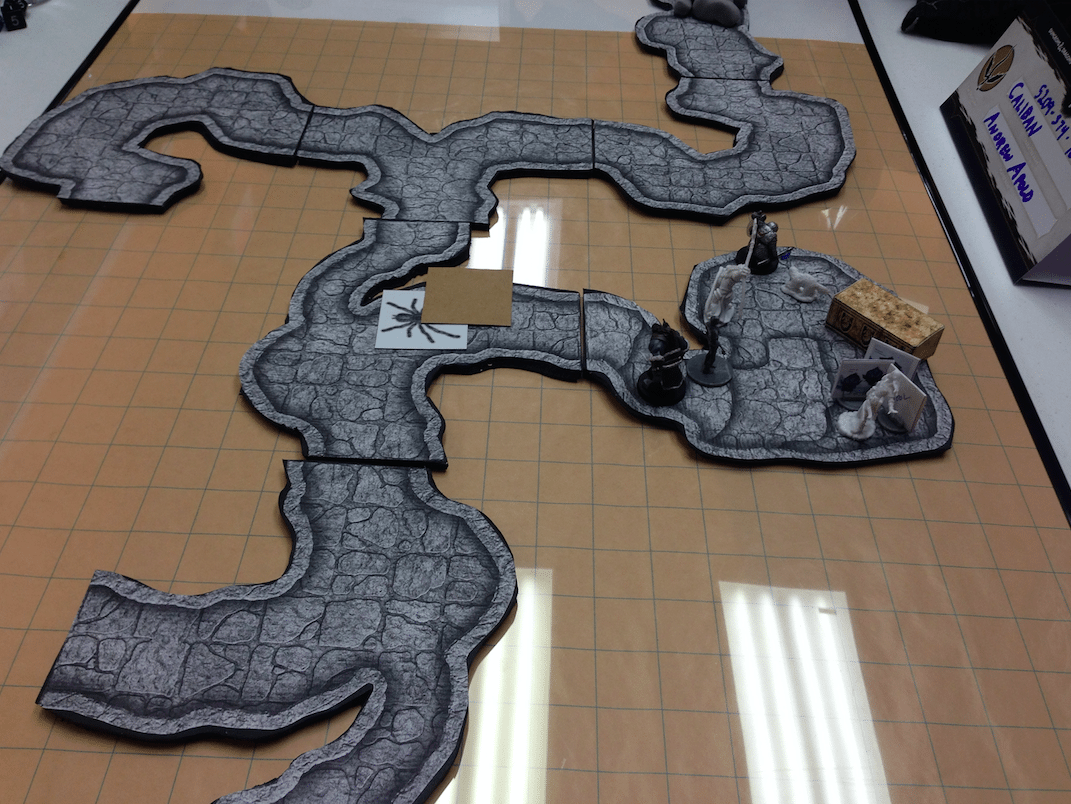
Fat Dragon also offers its 6″ x 6″ E-Z Tiles for dungeon locales as well as outdoor. These are standard-sized tiles available for a variety of locales – dungeon, village streets, wilderness ruins, rivers & streams, and a medieval ship.
Note: Fat Dragon offers both 2D and 3D products for fantasy settings as well as science fiction and modern-day. The company is also now offering files for 3D printer owners to print their own fantasy dungeon terrain – it’s called DragonLock and you can find more info here. I’ve also written previously about my experience using some of Fat Dragon’s 3D products here and here.
Inked Adventures
Staying with the tiles theme, I absolutely love the classic look and feel of the dungeon tiles from Inked Adventures. These tiles have an almost cartoonish style to them, with thick lines and bright colors – I mean, just look at the dungeon entrance below. If you’d like to try-before-you-buy, they have a free Starter Pack that will give you a good idea of the quality of the artwork.
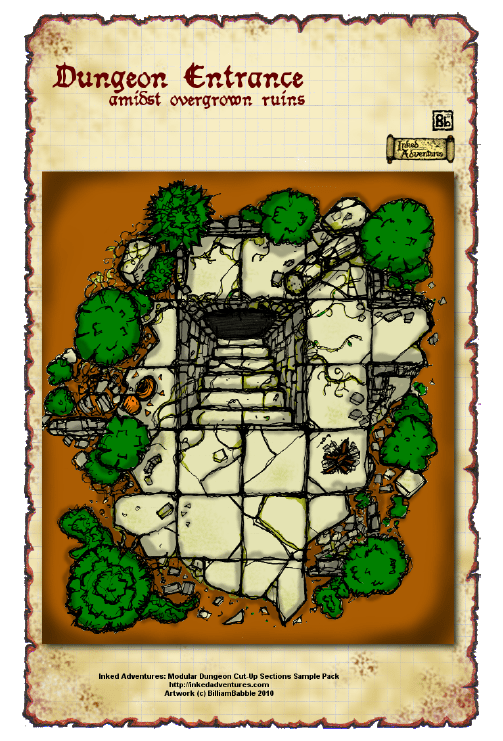
If you like the style, then you’ll want to start with the Basic Pack that offers up 36 pages of full-color 2D terrain and other objects you’d find in a dungeon setting.

Old School Dungeons
I haven’t yet had a chance to use the tiles from Old School Dungeons, but I couldn’t pass up the 150 page PDF file that was on sale for $2 (regularly $20). At the time I write this, the price is still $2, and this book is filled – FILLED – with so many incredibly useful terrain tiles. How many? 757 tiles, and you can print as many as you like… whenever you need them. There are dungeon halls/corridors, water tiles, lava tiles, and even ice tiles. What I like about this booklet is that they provide an amazing number of transition tiles that you could use with the room tiles from the previously mentioned Inked Adventures. The hand-drawn styles match up fairly well, as do the colors.
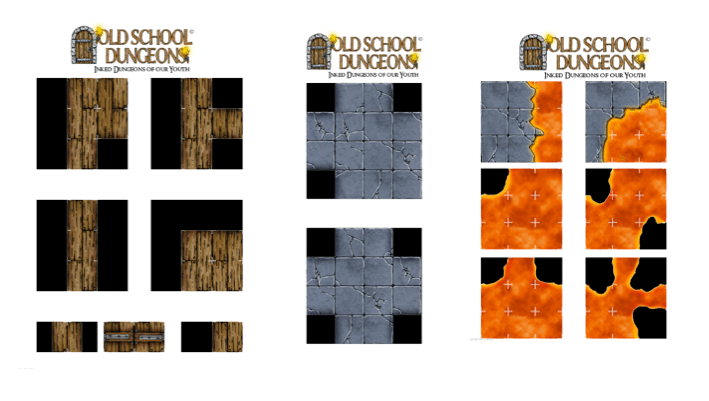
Handcrafted Dungeons
For something truly unique in the 2D terrain world, you’ll want to check out the Handcrafted Dungeon products from Outland Arts. These PDF files contain 2D terrain images that have actually been crafted by hand:
[E]verything you see was either made by hand, or built from a scratch model kit as in the case of the skeletons. We made the tiles from an air dry clay, used real stones, sand, and twigs, scraps of wood and then stained, painted and antiqued the tiles. Even the arms and armor on the skeletons was hand built.
The final results are then photographed and converted to 1″ gridded tiles that you can print out for something truly eye-catching. The images here (photos of an actual dungeon crawl I created for my gaming group in about five minutes using about 17 of the 126 total tiles) don’t do them justice, and until you print one out full-scale and in color, you just won’t get the full effect. I don’t even mount them on foam core board — just print on card stock and they do great. There are dozens and dozens of plain/empty hallway, three- and four-way intersections, and room tiles that can be used over and over again to keep a consistent style to your dungeon. The only drawback that I’ve found to them is that maybe a tenth of the tiles (they call them ‘staged tiles’) are almost too unique, creating a story on their own that you might not want; a bridge covered with the skeletons of fallen warriors, for example, looks amazing but will likely only be used once in a campaign.

Currently, there are only two PDF products available – Handcrafted Dungeons: Basic Dungeon Tiles Set 1 and Set 2.
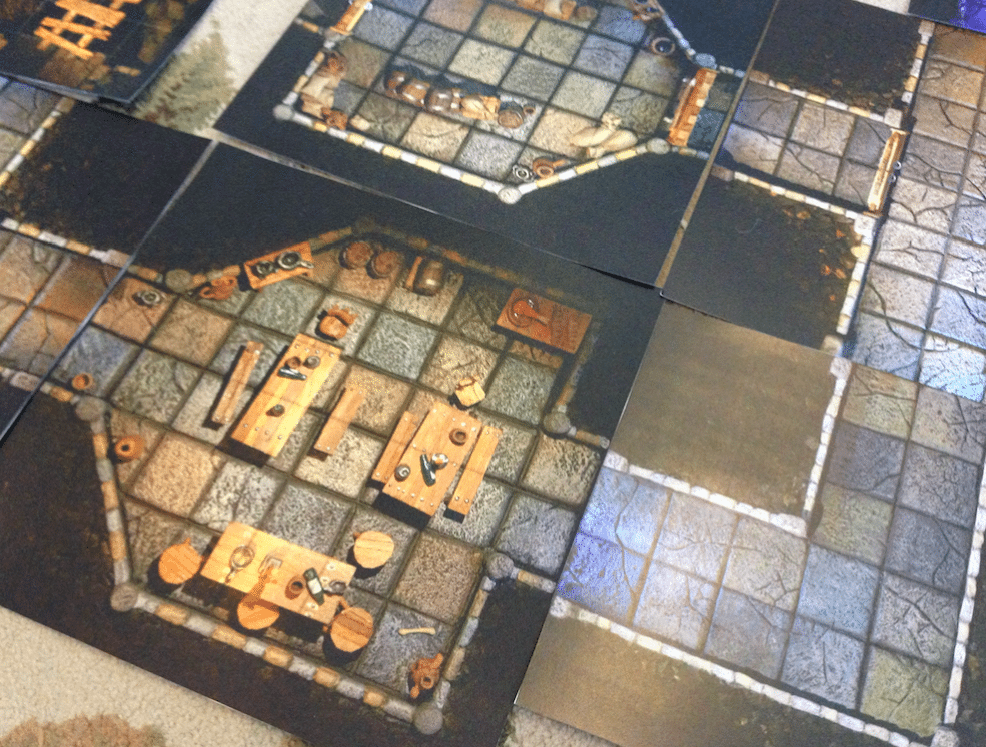
Each PDF is $12.99 – Both sets have 63 tile pieces each, but you can grab a free 10-page sample to try-before-you-buy and print out a few and see this amazing method of terrain creation for yourself. Set 3 is supposedly in production and will focus on Caverns… I own Sets 1 and 2, and I cannot wait to see the final results of Set 3.
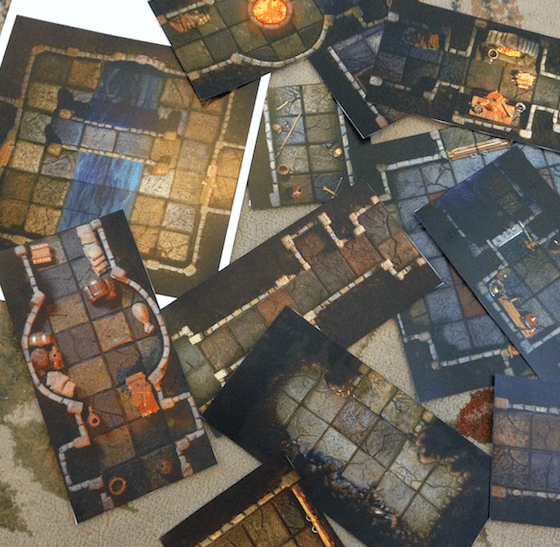
Pathfinder/D&D Maps and Tiles
I know that there were dozens of folded maps published for D&D 4e over the years, and there was also a D&D Tile Set product line (still available, too). Wizards put out an incredible number of specialty maps and tiles, including some for specific adventure locales (such as one called Shadowghast Manor). I’ve seen a number of DMs using them, but I currently don’t own any. I like the detail of the D&D folded maps and the fact that they lay flat (mostly), but the ones I’ve encountered seem to be easily torn or bent so care must be taken.
What I have purchased instead are a few Flip-Mat products from the folks at Paizo. These are folded and laminated and can be easily written on with wipe-off markers. They don’t lay as flat initially as the Wizards’ folded maps, but will settle down after a few minutes and can easily be flattened by placing a few heavy objects in the corners.
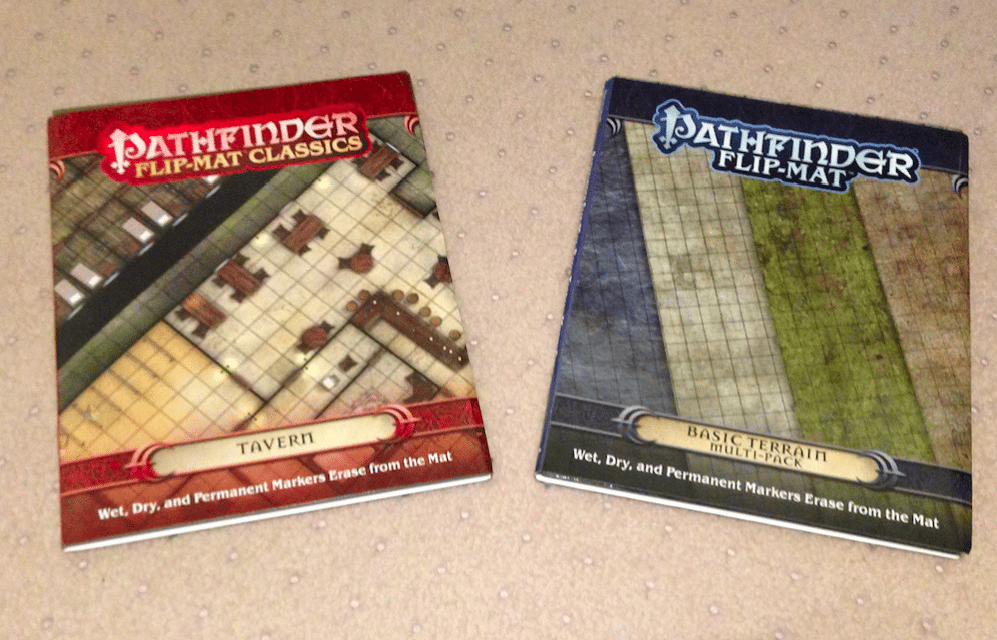
I pick these up as the need arises, but the one that I like the best is a simple two-pack of Flip-Mats called the Basic Terrain Multi-Pack. Sometimes I just need a gridded sheet without walls or other printed details. This pack offers four options – wild plain, city square, arena floor, and open sea. Between those four patterns, I’m rarely at a loss for a wide-open mat for combat or simple placement of players and obstacles. Each map is 24″ x 30″ when unfolded, by the way.
The other version I own is the Pathfinder Flip-Mat Classics: Tavern. It’s a tavern. Enough said, right? It also includes a small barracks (on the same side) and on the flip side is a solid green grass map. This isn’t the Seedy Tavern map, by the way. I run a clean campaign.

I’m now pondering a purchase of the Woodlands map, as well as the City Gates map as it’s always nice to have the players do a bit of roleplaying to convince the guards to let them in and it’s a nice layout to boot.
Lord Zsezse Works
I’m not quite certain about how to pronounce ‘Zsezse’ but the stuff sold on RPGNow.com from this source is absolutely incredible. I started by downloading one of the free Battlemap offerings titled The Hall of the Well, printed out on card stock, and then used spray adhesive to apply to some foam core. The quality of the artwork and colors blew my players away.

My second time using a Lord Zsezse product was another free download titled Bog of Hope. This one was a little larger and I got to use it to represent a Myconid grove the players uncovered in the Underdark. Once again, the design fit perfectly with what I was needing. I’ve since purchased a few of the larger battlemaps — one of them is called Temple of Abbadon (below), and this was a crazy adventure I ran recently where the players had to split up and head to the various corners of the temple.
Most of the battlemats come with full poster maps (that can be printed as one large print job) and as sections that you print out on 8.5×11″ paper and then assemble – the temple I assembled consisted of 20 individual PDF pages that I glued onto foam core board and then cut into six smaller, transportable sections – yeah, it’s big! You can read more about it here. I think my players were speechless for about a minute while I set it up.
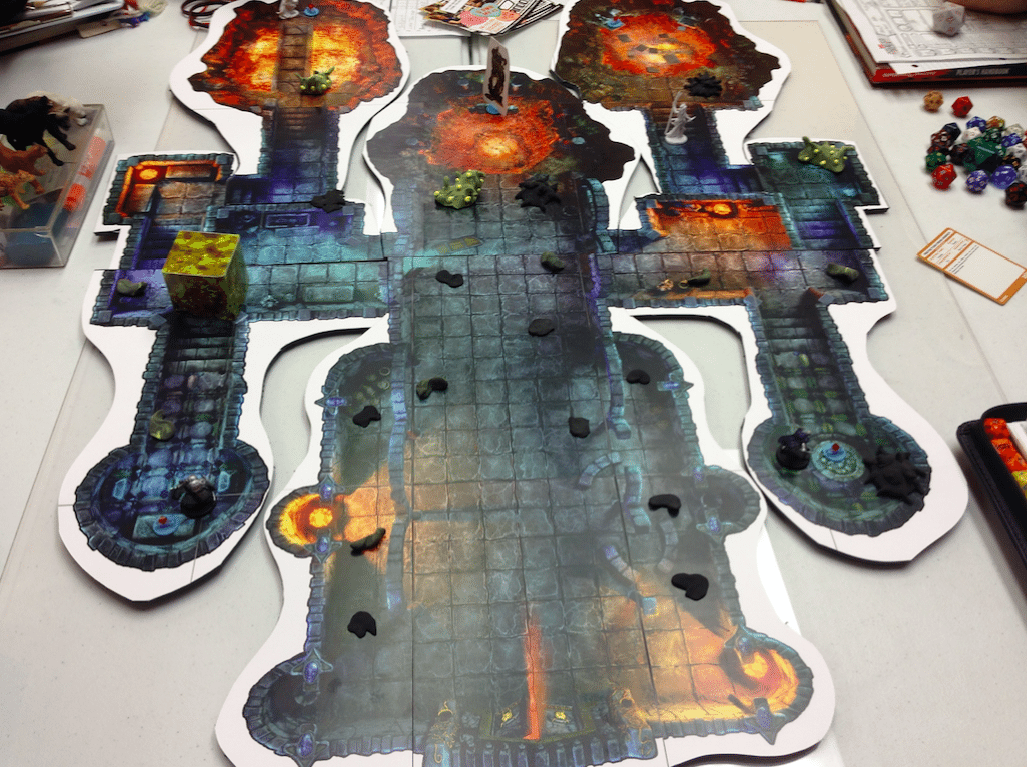
The only drawback I can find with Lord Zsezse’s Battlemaps is that the maps are static images (there is a little fine-tuning you can do within Acrobat for some maps but not all) and for most of them, you’ll need to tailor the adventure to fit what is seen on the mat. For example, there’s a treasure chest in The Hall of the Well that I simply told my players to ignore. “It’s not really there.” I hated that, and I guess I could have glued something over it or placed a rock or other object. Still… when you see the detail on these battle maps (the colors and textures are beautiful — see the closeup image below), you’ll immediately start trying to find ways to incorporate them into your game.
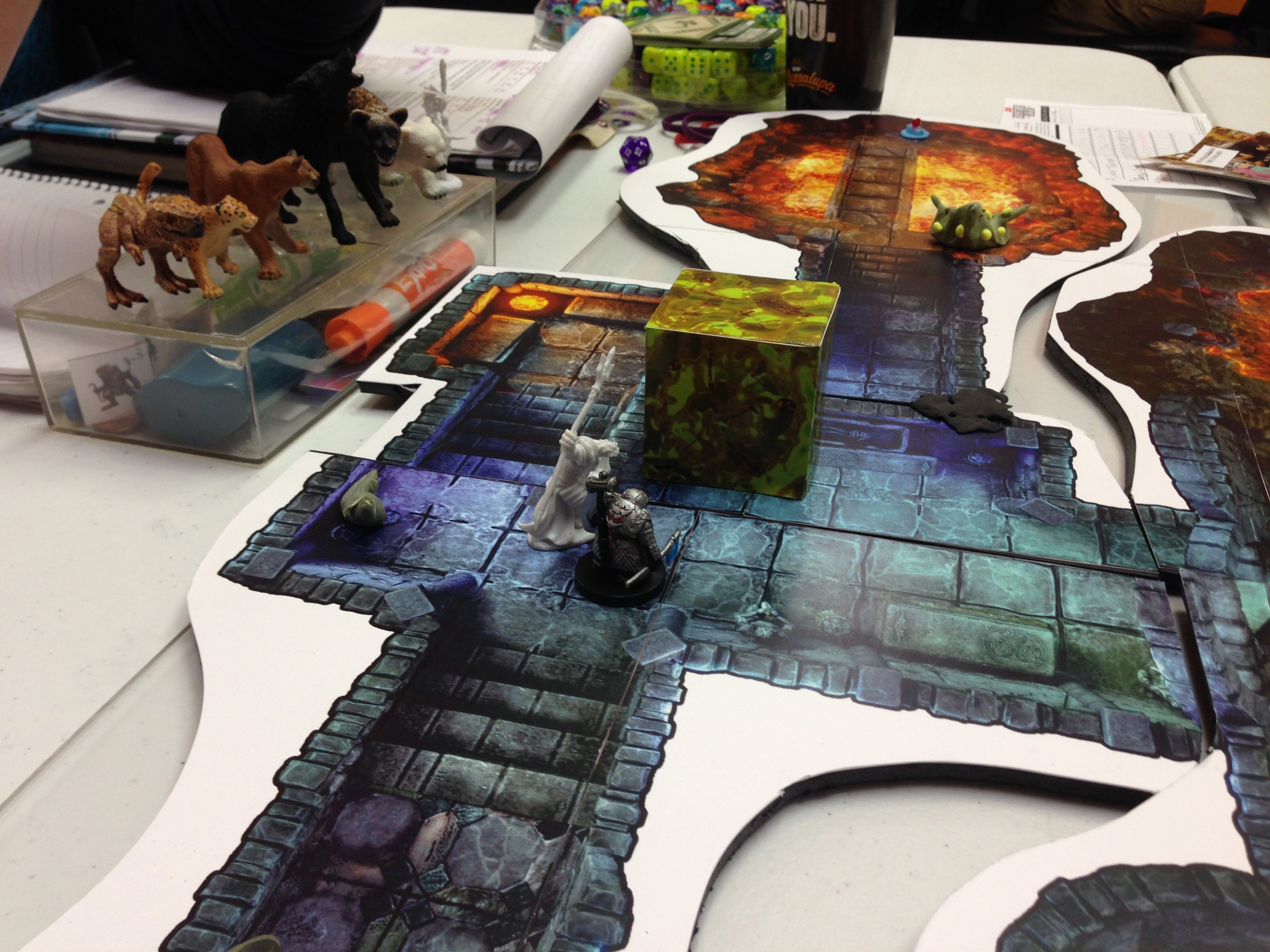
Note: When downloading files from RPGNow.com, take a look at the far right column that will list additional products that you can add to your order. Frequently, this list will contain other FREE files from the same publisher(s) of the product(s) you are preparing to download as well as similar free products from other companies. There’s a simple ‘Add to Cart’ button that will allow you to add on additional freebies that are often nothing more than bonus rooms, corridors, and dungeon-y objects. But hey… free!
Custom Maps
I’ve written before about my method of creating custom terrain maps using the Roll 4 Initiative laminated mat.

Basically, I take the 2×3′ gridded mat and photocopy it at my local print shop ($2 to $3 a copy depending on coupon) and then I just draw in the details with colored markers. I can fold it up or cut it up… whatever I need. I’ve used this method to create a custom four-deck ship, a two-level UFO (seen above), and a five level tower (below). The mat is laminated so you can draw on it with wipe-off markers, but I discovered that after a while the mat starts looking a bit… ragged and dirty. A photocopy ensures that I always have a clean gridded mat to work with and can cut up and glue to foamcore if necessary.
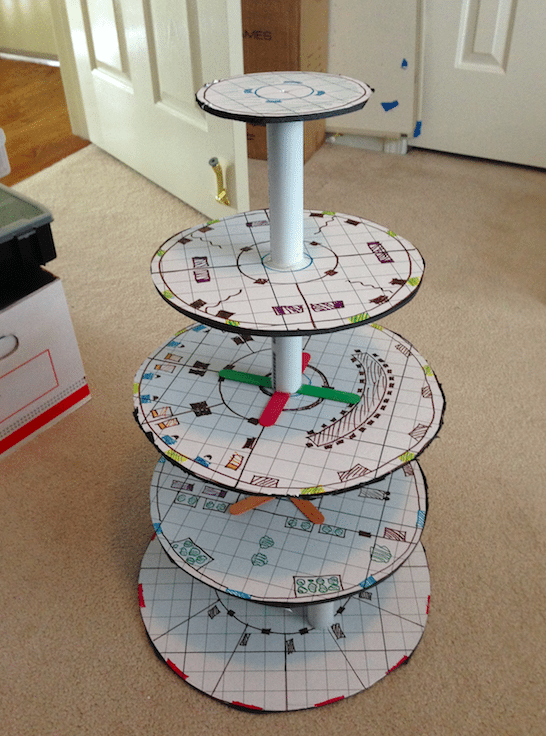
YouTube Mentors
There are a lot of videos on YouTube that will show you how to construct 2D and 3D dungeon tiles as well as accouterments such as chairs, tables, traps, and more. There are two YouTube channels that I really enjoy watching for ideas and just to see what others are doing out there, and both of them offer some outstanding How-To videos on creating 2D terrain tiles.
The first is theDMsCraft with DM Scotty – you can find his videos here. While he’s got lots of videos on constructing terrain tiles, here’s one to start you off and give you an idea on his style:
DM Scotty’s got a TON of videos… this guy does not play around, and most of his videos show some great techniques for very little cost. His focus is on 2.5D terrain — basically flat 2D tiles but with walls added using a layer or two of cardboard. This doesn’t obstruct the view of players but the hint of walls is a nice touch without crossing over into the complexity or added cost of 3D terrain.
Some other videos that I really enjoyed are his overview of a custom-made boss fight layout, an overview of his isometric tile design practices, and his outstanding creation of a dragon skeleton tileset. And just to see how crazy he can get, take a look at his Doom Skull – he’s got a couple videos that detail how he made this crazy thing with light-up eyes and zombie-tentacles.
DM Scotty also maintains an incredible forum where users post photos and advice; a great example is this user who tackled the original AD&D Castle Ravenloft. With Curse of Strahd‘s release just around the corner, DM Scotty has already given me way too many ideas…
TheDMG.info is another great source of ideas and techniques. With over 80 videos and growing, you’ll find some great stuff here. Start with DMG#000 that has Gareth explaining the reasons for his choice of 2.5D terrain versus 3D or jump straight to his first actual How-To video below:
If you watch the videos in order, you’ll discover a great method for creating reusable tiles that look good and won’t cost you a fortune. You’ll learn how to make stairs, how to simulate fog of war (#010 is great, and watch him put together an amazing dungeon in real time), and then get into dungeon details like chests, traps, and more. He’s also got some rockin’ intro music for each video.
Of course, much of his tutorials uses that crazy metric system (Centimeters? Centimeters? Really?), but I can forgive Gareth for such great detail in his instructions. He references DM Scotty often, so between the two channels, you’ll find plenty of ideas for your table.
Summary
There’s no denying that I’m a huge fan of both 2D and 3D terrain and dioramas when it comes to Dungeons & Dragons. I could spend hours and hours investigating the discussion forums, YouTube videos, and other terrain products… it’s a real rabbit hole for me. Hopefully you’ve found some ideas here and maybe discovered a few new products that might be useful to your campaign or gaming group.
When it comes to the history of RPGs, I just cannot get enough. If you have any additional details about any of the above products (especially the legacy/older products), please share in the comments. I’d love to see photos or hear your own thoughts on both old and new terrain products.
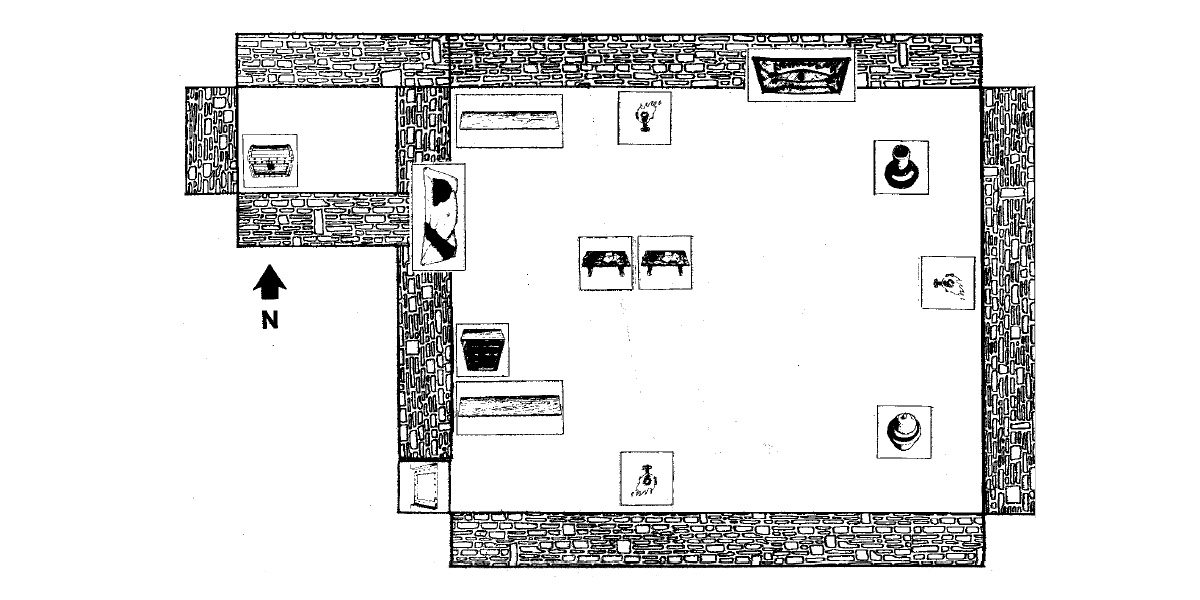



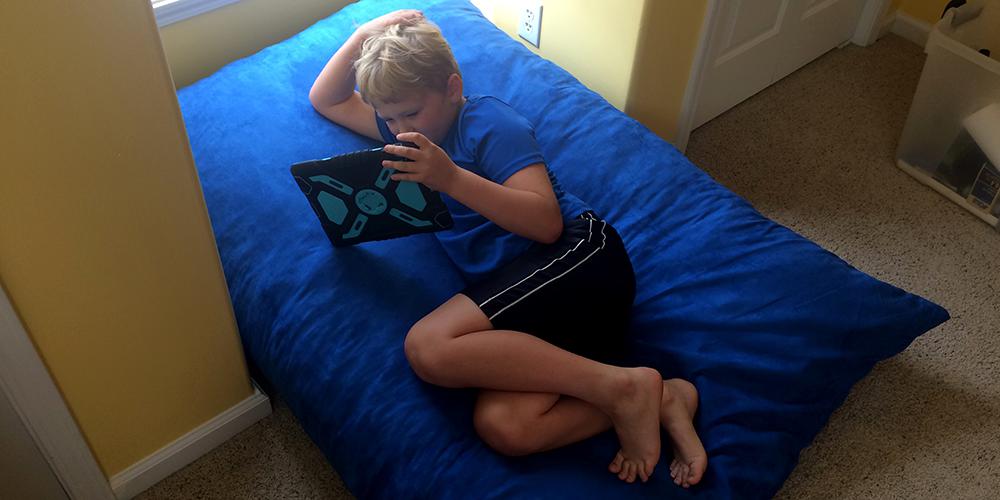
Love this.
We have sheets and sheets of huge 4′ x 4′ graph paper strew about, hanging from the game room. We have yet to totally eschew 2D maps, in spite of the fortune spent on Dwarven Forge KS.
The pumpkinhead bear is a jack o bear from Chaosium’s Runequest. Not a surprise to find such a tileset packaged with the BRP Quickstart rules. First came RQ, then Call of Cthulhu. At this point they started referring to their RPGs as being part of a Basic Roleplaying system, and produced that little introductory pamphlet. Subsequent BRP games included Stormbringer, Elfquest and Ringworld.
The Berkely Game Co offerings look very similar to what Chessex sells, including the name “Megamat.” I wonder if it’s the same company, or if they were bought by Chessex.
those Dragon magazine ads really took me back. I too wondered about those products when I relied solely on Waldenbooks to find role playing products. I just wanted to mention Games Workshop UK’s excellent series of floor plans, Dungeon Rooms, Dungeon Lairs and Dungeon Caverns. They were collected into one 48 page book in 1990 titled Warhammer Dungeon Floor Plans. They suffer from the same problem of depicting odds and ends that the DM might not want included in their room description. I owned the set and got many miles out of them.